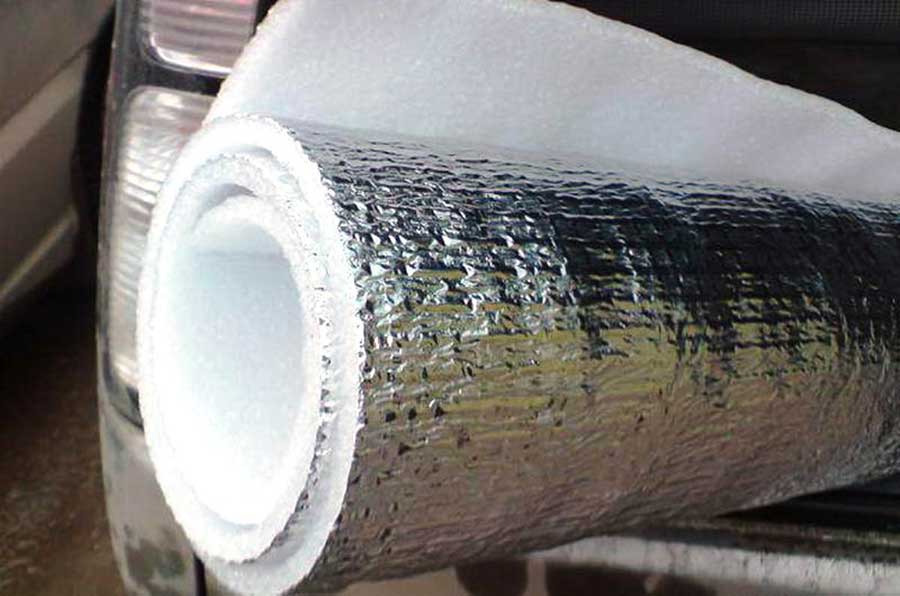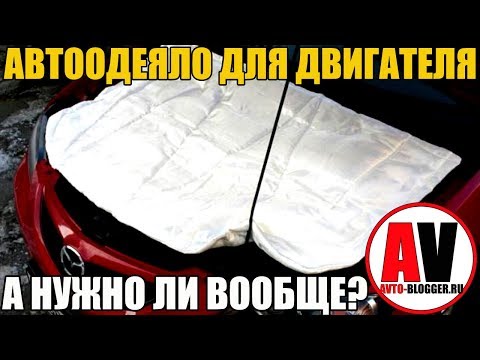
Insulation for the car
Content
Insulation for the car allows you to save heat in the internal combustion engine, its cooling system and the battery. Thanks to the insulation, a car enthusiast can quickly warm up the internal combustion engine in cold weather (while saving fuel), heat up the interior, and get rid of ice on the hood. However, the insulation for the car also has disadvantages. Among them are the possibility of overheating, a drop in motor power, the likelihood of a low-quality product catching fire. The low service life of most of these "blankets" (about one or two years) with their rather high cost also upsets car owners more.
the following are the advantages and disadvantages of using heaters for the internal combustion engine of a car, according to which you can make an appropriate decision on the appropriateness of the purchase, as well as a rating of popular heaters. If you have something to add to the material, please comment below.
Advantages and disadvantages of an auto blanket
The experience of using a heater for a car also goes back to the old days, when cars were carbureted, and 76th gasoline was used everywhere. Naturally, such cars warmed up very slowly in frost, and cooled down, respectively, quickly. However, these times are long gone, cars have become injection, and gasoline is more high-octane. Accordingly, the time for their warming up is spent less.
Currently, there are three types of heaters - internal combustion engines, radiators and batteries. Let's start the review with the most common - "blanket" for internal combustion engines. The advantages of using it are as follows:
- The motor warms up faster at low temperatures. This fact is ensured by the effect of a heat shield, which prevents the heat from the internal combustion engine from rising up and spreading through the engine compartment and heating the hood.
- After stopping the power unit, the latter remains warm for a long time. This becomes relevant in the case of short stops, then it is easier and easier to start the car.
- Thanks to the use of insulation for the car hood reduced warm-up time. This follows from the first paragraph of this list.
- If the machine is equipped with automatic heating by temperature, then the number of ICE starts per night is reduced by 1,5 ... 2 times (for example, by 5 to 3).
- Ice does not form on the surface of the hood. This becomes possible due to the fact that the heat from the motor does not heat it up, and, accordingly, moisture from the outside does not crystallize.
- A little heater reduces noise load both inside the car and outside.
Before describing the shortcomings, it is necessary to clarify a few nuances on which they may depend. namely, the insulation works differently with turbocharged and atmospheric ICEs, at different temperatures (for example, -30 ° and -5 ° С), under different driving conditions (in the urban cycle and on the highway), when air is taken from the radiator grill or from the engine compartment. The combination of these and other objective conditions gives a different result of using an auto blanket for an internal combustion engine, a battery and a radiator. That is why often such blankets can lead to the following troubles:
- overheating of the internal combustion engine, which in itself is bad, and can threaten the failure of its individual parts;
- at a relatively high temperature (about -5 ° C ... -3 ° C), ignition coils and / or insulation of high-voltage wires may be damaged;
- if warm air enters the system, then there is a risk of late ignition, which may increase fuel consumption;
- usually, when using a heater for a car, the power of the internal combustion engine drops, naturally, fuel economy is out of the question;
- when buying a low-quality blanket for an internal combustion engine, it may ignite!;
- most modern heaters for a car battery, its internal combustion engine or radiator have a short service life - about one to two years.

Is it worth using a car blanket?

Using an auto blanket
So, the decision on whether to buy an internal combustion engine heater or not to produce it depends on many factors. namely, if you live in latitudes where in winter the temperature drops to -25 ° C and below, and at the same time the engine on your car warms up for a long time, then yes, you should think about buying. But if the temperature in winter in your area rarely drops below -10 ° C, and at the same time you are the owner of a modern foreign car with a good heating system, then it is hardly worth worrying about an auto blanket.
Rating of the best heaters
First of all, we will discuss heaters for internal combustion engines, since they are more popular products than their counterparts for the radiator and battery. In accordance with the reviews of car enthusiasts on the Internet, at present the most common trademarks under which the mentioned products are produced are TORSO, STP HEATSHIELD, SKYWAY, Avto-MAT and Avtoteplo. About them and will be discussed further.
Car blanket TORSO
A distinctive feature of the TORSO auto blanket is its low price. For example, a product measuring 130 by 80 cm at the end of 2021 is about 750 rubles. However, a significant drawback of this product is the lack of official certification. Auto blankets of different sizes are on sale, so they can be used both on small cars, and on crossovers and SUVs. The warranty period of this car blanket is 3 years. The mass of the product measuring 130 by 80 cm is 1 kg. The article number is 1228161.
STP Heat Shield Insulation

ICE insulation StP HeatShield
The STP Heat Shield car blanket is also available in different sizes, both for cars and SUVs. For example, there are sizes 600 by 1350 mm with the article number - 058060200, and 800 by 1350 mm - 057890100. A distinctive feature of these products is the presence of not only heat, but also sound insulation. In summer, the protection can also be used between the ICE and the passenger compartment, which reduces the noise load in the vehicle interior. The blanket consists of the following materials:
- non-woven fabric resistant to oil, fuel and other process fluids;
- noise and heat-absorbing layer;
- adhesive layer, resistant to high temperature extremes, and serving as the mechanical basis of the insulation.
The product is attached using the 8 clips included in the kit. With their help, you can attach a blanket in the summer. In winter, it can be laid directly on the engine body. The cost of both of these models is approximately the same and is about 1700 rubles.
Skyway car blanket
Under this brand, 11 models with different dimensions are produced. The peculiarity of the products lies in the excellent value for money. According to the reviews of many car owners, the blanket works for about 2 ... 3 years without loss of performance. Conditional disadvantages include an easy possibility of damage to the surface of the product, which is why it is necessary to install the insulation carefully so as not to damage it. Despite the differences in size, the price of heaters is approximately the same and amounts to 950 ... 1100 rubles as of the end of 2021.
«Auto-MAT»
Under this trademark, two types of auto blankets for internal combustion engines are produced - A-1 and A-2. Both models are similar to the products described above. They are non-flammable, non-conductive, resistant to acids, fuels, oils and various process fluids used in the car. The difference between them is the maximum temperature. namely, model A-1 withstands maximum temperatures up to +1000°C, and A-2 - +1200°C. there is also a model A-3, designed to insulate the battery. Its properties are similar to the first two. It differs only in size and shape. The price of an auto blanket for internal combustion engines as of the end of 2021 is about 1000 rubles apiece.
"Autoheat"
This is the most famous and popular blanket among domestic motorists. Its distinguishing feature is the fact that the manufacturer positions it as an engine compartment heater, and not a hood heater. The product can be used at temperatures up to -60°C, while it prevents ICE starting mechanisms from icing. Avtoteplo insulation is a fireproof product, and can withstand temperatures up to +1200°C. The auto blanket is not afraid of moisture, oil, fuel, acids and alkalis. It has a serious service life, can be used with both cars and trucks. According to the reviews of motorists, it is best to buy the appropriate auto blanket, released by a company from Chelyabinsk with the same name "Avtoteplo". also, when buying, check the availability of all permits and a passport for both the purchase and the product. The price at the end of 2021 is about 2300 rubles, depending on the size. Blanket item number 14 - AVT0TEPL014.
As of the end of 2021, compared to the beginning of 2018, all of these auto blankets have risen in price by an average of 27%.
Do-it-yourself car heater
in order not to spend money on buying factory-made insulation, you can make a car blanket with your own hands and lay insulation for the car under the hood or on the car's radiator grille. In this case, you can use various available materials (necessarily non-combustible). You can insulate the following areas of the car:
- the inside of the hood;
- engine shield (partition between ICE and interior);
- cooling radiator;
- the lower part of the engine compartment (from the protection side);
- insulate the battery.
However, the most important in this case will be the heaters of the battery, hood and radiator. Let's start with the last one.
Insulation of the radiator
To insulate the radiator, you can use different materials - a piece of thick cardboard, felt fabric, leatherette, and so on. There are two nuances that you should definitely keep in mind when warming. First - protection must be removable. This is especially true of powerful gasoline engines. This is due to the fact that when warming, the protection will need to be removed in order to prevent overheating. Second - the material must not be hygroscopic (should not absorb moisture). Otherwise, it will lose its properties, and it will simply look ugly.
Unfortunately, many modern cars are designed in such a way that it is difficult, and sometimes impossible, to fix home-made insulation behind the radiator grille. Therefore, if there is an appropriate heater for sale for your car, then it is better to use it.
Insulation for internal combustion engines
One of the most popular types of self-insulation of internal combustion engines is the installation of the appropriate material on the inner surface of the hood. To do this, use different materials, namely:
- Folgoizolone. It is an expanded polyethylene foam. Resistant to moisture, oil and fuel. The material is fireproof with a working temperature range from -60°С to +105°С.
- Penofol. A material similar to the previous one is also a foamed polyethylene foam. However, it is implemented in three versions - “A” (on one side the material is covered with foil), “B” (foil on both sides), “C” (on one side there is foil, and on the other with a self-adhesive base).
A significant disadvantage of insulating the inner surface of the hood compared to laying a blanket on the internal combustion engine is that in this case an air gap is formed between them, which will reduce the effectiveness of the insulation. Therefore, it is still better to use regular auto blankets.
The thicker the material you buy, the better the sound and heat insulation will be. It is recommended to cut pieces of material according to the shape of the inner surface of the hood in order to produce the insulation as efficiently as possible. As for the fastening methods, they may vary depending on the material used and the shape of the hood. Often, adhesive materials (self-adhesive insulation), nylon ties, staples, and so on are used for this.
battery insulation
Battery insulation
there are also regular battery heaters that work on a similar principle. They are made from the same materials as the car blanket, so they are resistant to electrolyte, oil and other process fluids. However, its use is associated with some nuances.
So, the battery insulation should be installed only in very severe frosts, and mainly on those batteries that have significant geometric dimensions. Otherwise (for example, if your car has an old and already weak battery), it’s easier to simply remove it for the night and take it with you so that it spends the night warm (and recharge if necessary).
the basic problem is that if the frost is small, and the battery gets very hot during the ride, then there is a possibility of it exploding. Naturally, no one needs this emergency. Therefore, we repeat that the heater should be used only in significant frosts.
it is battery heaters that are sold ready-made for different sizes of batteries. they can also be made independently, using non-combustible insulation material, preferably without foil coating, in order to exclude the occurrence of a short circuit in the car's electrical network.
Hack and predictor Aviator
So, it is worth using an internal combustion engine insulation only in very severe frosts and when your car is gaining temperature for a long time. Otherwise, the auto blanket, on the contrary, can do a disservice. If you decide to buy insulation, then do it in trusted stores, and choose those models that are primarily safe (made from non-combustible materials). Considering the considerable cost of the auto-blanket and their low service life, it is possible to insulate the radiator and internal combustion engine with your own hands. So you save a lot, and even more effect is possible when choosing a sufficiently effective material and its correct installation.